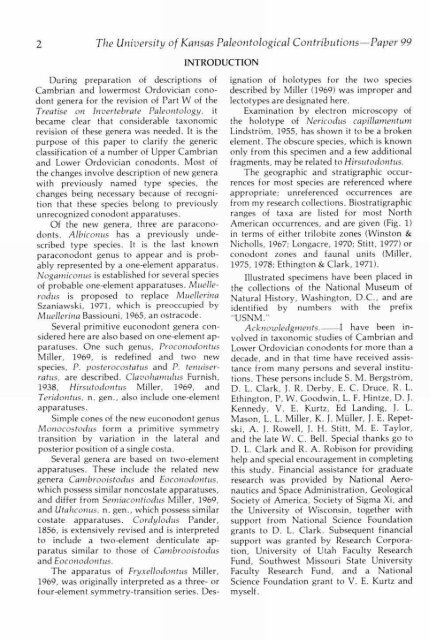View - KU ScholarWorks - University of Kansas
View - KU ScholarWorks - University of Kansas
View - KU ScholarWorks - University of Kansas
Create successful ePaper yourself
Turn your PDF publications into a flip-book with our unique Google optimized e-Paper software.
2 The <strong>University</strong> <strong>of</strong> <strong>Kansas</strong> Paleontological Contributions—Paper 99<br />
INTRODUCTION<br />
During preparation <strong>of</strong> descriptions <strong>of</strong><br />
Cambrian and lowermost Ordovician conodont<br />
genera for the revision <strong>of</strong> Part W <strong>of</strong> the<br />
Treatise on Invertebrate Paleontology, it<br />
became clear that considerable taxonomic<br />
revision <strong>of</strong> these genera was needed. It is the<br />
purpose <strong>of</strong> this paper to clarify the generic<br />
classification <strong>of</strong> a number <strong>of</strong> Upper Cambrian<br />
and Lower Ordovician conodonts. Most <strong>of</strong><br />
the changes involve description <strong>of</strong> new genera<br />
with previously named type species, the<br />
changes being necessary because <strong>of</strong> recognition<br />
that these species belong to previously<br />
unrecognized conodont apparatuses.<br />
Of the new genera, three are paraconodonts.<br />
Albiconus has a previously undescribed<br />
type species. It is the last known<br />
paraconodont genus to appear and is probably<br />
represented by a one-element apparatus.<br />
Nogamiconus is established for several species<br />
<strong>of</strong> probable one-element apparatuses. Mziellerodus<br />
is proposed to replace Muellerina<br />
Szaniawski, 1971, which is preoccupied by<br />
Muellerina Bassiouni, 1965, an ostracode.<br />
Several primitive euconodont genera considered<br />
here are also based on one-element apparatuses.<br />
One such genus, Proconodontus<br />
Miller, 1969, is redefined and two new<br />
species, P. posterocostatus and P. tenuiserratus,<br />
are described. Clavollannilus Furnish,<br />
1938, Hirsutodontus Miller, 1969, and<br />
Teridontus, n. gen., also include one-element<br />
apparatuses.<br />
Simple cones <strong>of</strong> the new euconodont genus<br />
Monocostodus form a primitive symmetry<br />
transition by variation in the lateral and<br />
posterior position <strong>of</strong> a single costa.<br />
Several genera are based on two-element<br />
apparatuses. These include the related new<br />
genera Cambrooistodus and Eoconodontus,<br />
which possess similar noncostate apparatuses,<br />
and differ from Sein iacontiodus Miller, 1969,<br />
and LI taliconus, n. gen., which possess similar<br />
costate apparatuses. Cordylodus Pander,<br />
1856, is extensively revised and is interpreted<br />
to include a two-element denticulate apparatus<br />
similar to those <strong>of</strong> Cambrooistodus<br />
and Eoconodontus.<br />
The apparatus <strong>of</strong> Fryxellodontus Miller,<br />
1969, was originally interpreted as a three- or<br />
four-element symmetry-transition series. Designation<br />
<strong>of</strong> holotypes for the two species<br />
described by Miller (1969) was improper and<br />
lectotypes are designated here.<br />
Examination by electron microscopy <strong>of</strong><br />
the holotype <strong>of</strong> Nericodus capillarnention<br />
LindstrOm, 1955, has shown it to be a broken<br />
element. The obscure species, which is known<br />
only from this specimen and a few additional<br />
fragments, may be related to Hirsutodontus.<br />
The geographic and stratigraphic occurrences<br />
for most species are referenced where<br />
appropriate; unreferenced occurrences are<br />
from my research collections. Biostratigraphic<br />
ranges <strong>of</strong> taxa are listed for most North<br />
American occurrences, and are given (Fig. 1)<br />
in terms <strong>of</strong> either trilobite zones (Winston &<br />
Nicholls, 1967; Longacre, 1970; Stitt, 1977) or<br />
conodont zones and faunal units (Miller,<br />
1975, 1978; Ethington & Clark, 1971).<br />
Illustrated specimens have been placed in<br />
the collections <strong>of</strong> the National Museum <strong>of</strong><br />
Natural History, Washington, D.C., and are<br />
identified by numbers with the prefix<br />
"USNM."<br />
Acknowledgments. I have been involved<br />
in taxonomic studies <strong>of</strong> Cambrian and<br />
Lower Ordovician conodonts for more than a<br />
decade, and in that time have received assistance<br />
from many persons and several institutions.<br />
These persons include S. M. Bergstrom,<br />
D. L. Clark, J. R. Derby, E. C. Druce, R. L.<br />
Ethington, P. W. Goodwin, L. F. Hintze, D. J.<br />
Kennedy, V. E. Kurtz, Ed Landing, J. L.<br />
Mason, L. L. Miller, K. J. Muller, J. E. Repetski,<br />
A. J. Rowell, J. H. Stitt, M. E. Taylor,<br />
and the late W. C. Bell. Special thanks go to<br />
D. L. Clark and R. A. Robison for providing<br />
help and special encouragement in completing<br />
this study. Financial assistance for graduate<br />
research was provided by National Aeronautics<br />
and Space Administration, Geological<br />
Society <strong>of</strong> America, Society <strong>of</strong> Sigma Xi, and<br />
the <strong>University</strong> <strong>of</strong> Wisconsin, together with<br />
support from National Science Foundation<br />
grants to D. L. Clark. Subsequent financial<br />
support was granted by Research Corporation,<br />
<strong>University</strong> <strong>of</strong> Utah Faculty Research<br />
Fund, Southwest Missouri State <strong>University</strong><br />
Faculty Research Fund, and a National<br />
Science Foundation grant to V. E. Kurtz and<br />
myself.
















